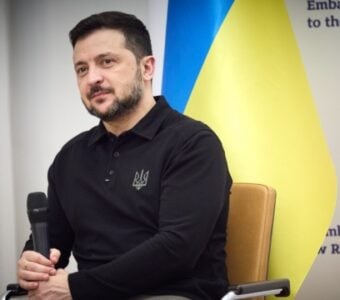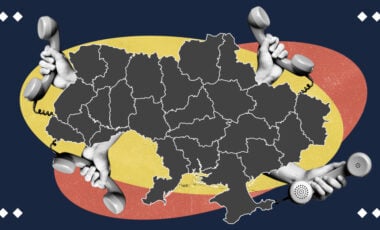35th anniversary of Chornobyl. The most significant books and films on this day
5 films, 5 books, and 2 places to help you better understand the tragedy that changed hundreds of thousands of lives forever

On April 26, 2021, we commemorate the 35th anniversary of the greatest man-made disaster in human history. The sad anniversary of the Chornobyl accident once again reminds us of the fragility of what's commonly called "stability and prosperity," the outrageous cynicism of the Soviet government, the powerlessness of the individual before the system, the devotion of liquidators and medical workers, fallen heroes and survivors. And also about hundreds of thousands of people who were forced to hastily leave everything they had in one day and go away "just for a few days to a safe place" only with children in their arms and documents, not yet realizing that this escape is forever.
Nearly three million affected Ukrainians (of whom more than 617,000 are children) are the human dimension of the Chornobyl disaster.
What were these people like? Probably like all of us now. Everyone had their fortunes, plans, likings, and favorite places to unwind, work that brought pleasure and money, ambitions and dreams. All of them, as well as the current migrants from the occupied territories, had to start all over again. Many ordinary USSR citizens didn't believe in the dangers of invisible radiation, just as some still don't believe in the coronavirus pandemic. These parallels are another reason to remember the events of 35 years ago because those who remain human in all situations, ready to provide help and support, understand how to accept them with dignity, and unite in the face of emerging threats are always stronger than any other circumstances and catastrophes.
We should read books and watch movies about Chornobyl. It's important to study one's own history at least to understand the words of one of the heroes of the Chernobyl TV series: "We never think that it can affect us. Someone, somewhere, but not me…"
What to watch
The Chernobyl TV series (2019)
Incredibly detail-accurate, the four-part HBO mini-series became the highest-rated show in history. Its value isn't only in the reconstruction's thoroughness and the most truthful retelling of events, but also in the mundaneness, these events are shown with, as if through the eyes of direct witnesses: Pripyat residents watching the "show" on the horizon, schoolkids going to class without noticing the dead birds falling straight from the sky, a confused miner doomed to death, who continues to behave routinely, footage of an empty city… And a bitter awareness of the audacity of modern man, who declared himself king of nature, but couldn't cope even with its smallest particle, an atom. The series is difficult to comprehend and teaches a lot because its plot isn't fiction, it was all real.
Chornobyl 3828 (2011)
The figures in this documentary title are 3,828 liquidators of the accident consequences at the power plant who were involved in work in the most dangerous "M" zone, on the roofs of the station. This 30-minute picture is for those who want to learn more about how the fight for cleaning the roof from graphite debris took place, the impossibility of using equipment where the work failed, the decision to use human labor. Endless changes in 2 minutes, terrible work of the living people conveyor. The film tells about the relationship between the liquidators. About genuine heroes with a shovel who saved the world, and those who happened to be among them, cherishing their fear.
Butterflies (2013)
Ukrainian mini-series based on the tragic events of April 26, 1986. This film is also about the Chornobyl accident, but it tells the story of what happened at the station through the prism of the first love of two young people who had no idea about the Chornobyl disaster. While watching the film, it becomes clear what the film's name means. Two lovers, like butterflies, fly to the fire with the feelings that suddenly arose, and the circumstances that accompany this love in the infected area. The film's special atmosphere is supported with skillfully selected music tracks, enhancing the effect of everything seen and heard, and complement and decorate the film.
There are no studio scenes in the movie. The film's main part was shot in Slavutych, which was transformed into Pripyat at the time of filming.
Babushkas of Chernobyl (2015)
These grandmothers live in the village, but not in the ordinary one. They live in the exclusion zone. Most of their former neighbors settled in new places in the 20th century, their husbands died, and, despite the ban, these stubborn women secretly returned to the area (in the film, they explain how they made their way through Polissya thickets) and settled here to live on their land. The poignant story, shot for three years by American documentary filmmaker Holly Morris, doesn't leave the viewer indifferent. The Chornobyl grandmothers survived the Holodomor, World War II, the Chornobyl explosion, and now continue to farm, grow vegetables and collect mushrooms in the zone of the nuclear disaster. According to the New York Times, this film, which tells the story of a generation of people who have a very strong connection to the land and the place, "conveys the subtleties and uncertainties of Chornobyl, as well as the resilience of the human soul."
Aurora (2006)
Oksana Bayrak's film tells the story of an orphan girl, Aurora from Pripyat. She dreams of becoming a ballerina, and her only friend is a nuclear power plant worker, whom she sees as her father. A naïve and pure child shows character during an explosion; she really wants to hide from danger, but also to warn everyone about it. Trying to save her friend, the girl receives a large dose of radiation, after which she's sent for treatment to the United States. There, the key events in the picture happen – hospital, ballet, music, dance, meeting with an idol, a famous choreographer. For him, meeting the fragile Aurora will be significant. It will make him realize that much of his life he lived wrong, that even such a small and severely ill girl finds the strength not to give up and fight for her existence.
What to read
The Chornobyl Prayer. Chronicles of the Future by Svitlana Aleksievych
This book isn't fiction, this book is a collection of facts and accurate information, interviews with people who've been at the epicenter of events.
The author didn't write fictional stories. She told only what others told: about life, about death, about fear. For eyewitnesses, Chornobyl became a war where the enemy was invisible and even more terrible. Radiation can't be touched or seen, but its consequences will last for many hundreds of years.
This book has been written for many years, and it's a herculean work. Memories and thoughts of people who'd like to forget everything. Read, think, cry, absorb these confessions. Chornobyl is a timeless catastrophe, it has no past and no future. But we may have a future if we don't allow this to happen again.
Chernobyl. History of tragedy, by Serhii Plokhii
Maidan helped historian Serhii Plokhii to write this book. After all, it was after the Revolution of Dignity that he managed to gain access to many documents from the former KGB archives. The marathon book tells about the events at the Chornobyl nuclear power plant from the explosion to the closure of the station in December 2000. The catastrophe and the first days after it are depicted almost minute by minute, increasing the emotional presence effect. The last story is dedicated to the construction of a new sarcophagus in May 2018. The author says that in the work process, overcoming the emotional shock of all broken destinies, destroyed health and lives was the most difficult thing for him. And it happened at a time when not only the Soviet Union but the entire world naively believed that the atom was finally subdued. The book-winner of the most prestigious British Baile Gifford Literary Prize was written in English and translated into several languages, including Ukrainian.
Crossing Chernobyl, Galia Ackerman
This book is called an expedition book. French writer Galia Ackerman admits: "I wanted to talk about 20 years of my life related to Chornobyl. This is a story about the zone, Pripyat, the people working in the zone, the settlers, trips, their conversations with the people who were involved in Chornobyl." The author met most of the story heroes in person. Her book will open readers to places they never knew existed. This special book is a journey through the world of phantoms and the living land, the Soviet past, and Ukrainian reality, and the author's inner journey through the world.
A Stroll to the Zone, by Markian Kamysh
Want to know about the life of a stalker? This book is for you. The author talks about his own experience of illegal tourism in the Exclusion Zone. The style of the story will build a picture of the real Pripyat in your imagination, but not because of boring documentaries. In the book, you won't find standard descriptions of the Zone, historical calculations, and reflections on the true causes of the Chornobyl accident. Here, you'll find a view from inside: emerald swamps, police ambushes, and legs beaten to bloody calluses. The night showers of Pripyat and the dawn magic of Polissia are threatening. Here is an attempt to answer the question of what is going on in the soul of a person who's been secretly exploring the forbidden land for years. The book is illustrated with photographs taken by the author himself.
Children of Chornobyl, by Yevhen Hutsalo
True stories about the tragic life of young heroes after Chornobyl. A little boy who tries to save a "rabid Chornobyl dog," a contagious one, as adults say. A girl who lived happily with her dreams and parents before the tragedy. And now, everything after, parents went somewhere "to earn money" because there's no job for them in this village. The boy who treats the migrant dealt short by fate with honey… All these heroes of the collection are vulnerable children's souls who are just beginning their journey. They still have a lot to realize but they already live by the laws of conscience, and the author believes that they'll continue to live by the same laws.
What to visit
Tours to Chornobyl
Seeing Chornobyl at least once, you look at the so-called "ordinary life" differently. Including your own. And this is perhaps the main meaning of trips.
You'll see with your own eyes the abandoned buildings, the red forest, the Ferris wheel, the school, the Prometheus cinema, the pier with the flooded dock. Climb to the observation deck at the Chornobyl nuclear power plant, feed giant catfish. Routes offered by tour operators, with strict adherence to the requirements of attendants, are quite safe for organized tourists. According to brochures, for a day walk around Chornobyl and Pripyat, you'll receive the same dose of radiation as for one hour of flight. This is 160 times less than the dose obtained for one fluorography. However, the instructions should be strictly followed: for example, you must not wear outdoor clothing and footwear in the Zone, should not touch metal objects, and collect mushrooms and wild fruits as they can still be dangerous.
Chornobyl Museum
The National Museum "Chornobyl" was opened in the capital of Ukraine on April 26, 1992, one hundred kilometers from the epicenter of the disaster. "Est dolendi modus, non est timendi dolendi" — this inscription welcomes visitors at the entrance to the exhibition. Translated from Latin, it means "There's a limit to sadness, but anxiety has no limit." From the very threshold, there's a complete immersion in the atmosphere of those terrible times; right at the entrance to the museum, they show how many people were injured and how many settlements were destroyed.
For the highest quality viewing of the exhibition, it's better to take a tour with a guide; the museum employs real professionals. But it's interesting to walk around the halls, read the diaries and records of the participants in the accident's liquidation, look at photos, read magazines. Thanks to the video effects in the museum, you can even feel present at the notorious fourth block of the Chornobyl nuclear power plant.
Unfortunately, due to quarantine restrictions, the facility may temporarily not receive guests, but the Chornobyl National Museum can now be visited online without leaving your home. A virtual tour of the exhibition, during which you can even hear the museum's sounds, is available on the website of the museum's online projects at the link.
Address: Khoryva Lane, 1, Kyiv.
































































